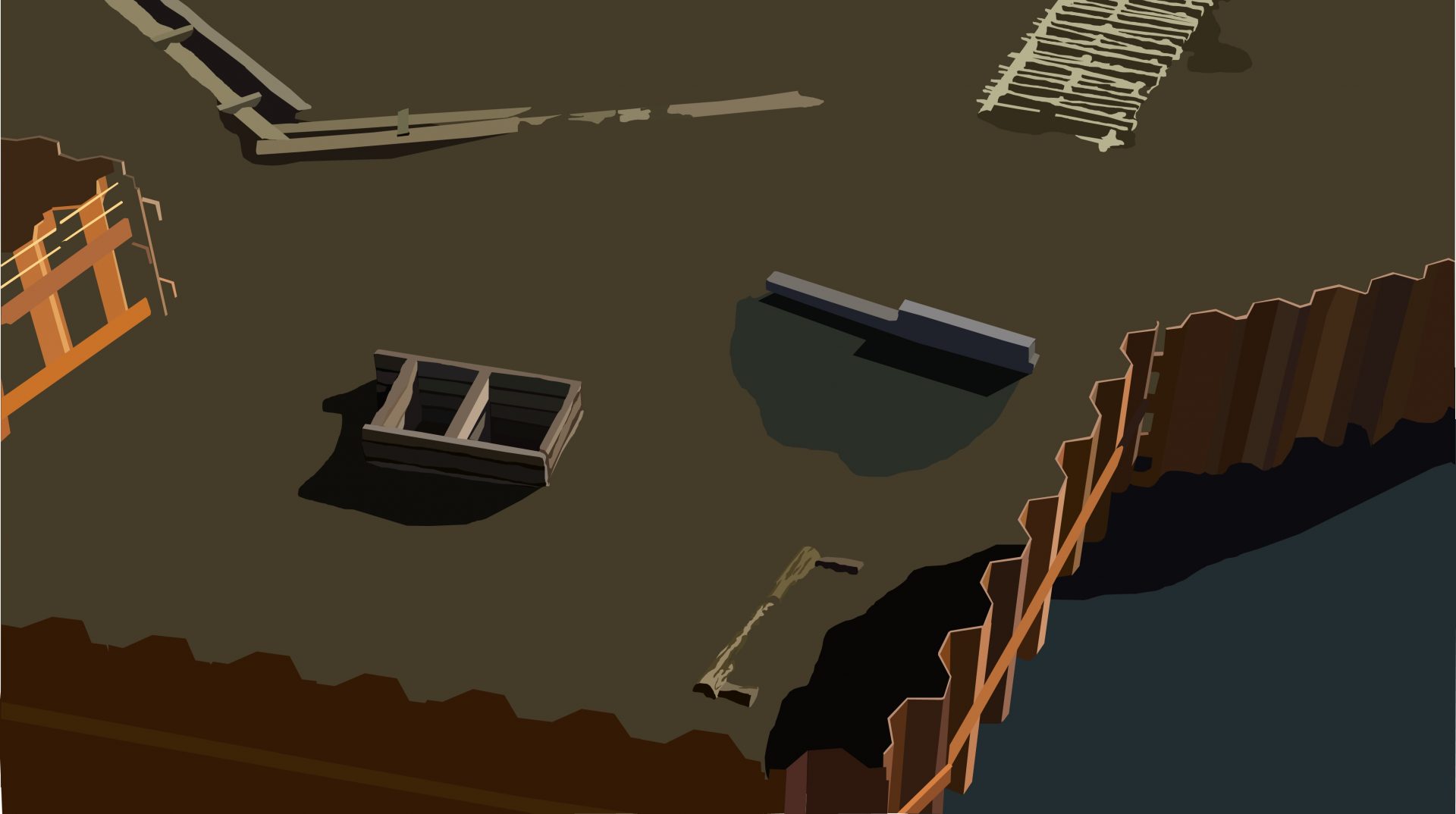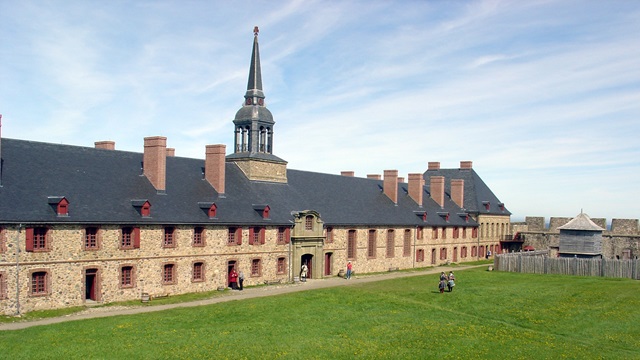The Curse of Oak Island- Season 7, Episode 12: Fortified
The following is a plot summary and analysis of Season 7, Episode 12 of the History Channel’s TV series The Curse of Oak Island.
[SPOILER ALERT!!!]
Plot Summary
Rick Lagina and Chris Barlow pay a visit to the Oak Island swamp, which Hurricane Dorian refilled with water the previous episode. Rick estimates that it will take two or three days to re-drain the swamp and resume their excavations of the areas of interest therein, and suggests that they ought to prioritize the excavation of the Paved Wharf.

Later that day, the Fellowship of the Dig meets in the War Room. There, Craig Tester reveals the results of the dendrochronological testing of the wharf in Smith’s Cove, samples from which were extracted in the previous episode. According to dendrochronologist Dr. Colin Laroque, who analyzed one of the samples, the wharf is made of red spruce felled in 1741. The treasure hunters express some surprise at this result, as many of them had expected the wharf to be contemporaneous with the nearby slipway, which is believed to have been constructed around 1769. Doug Crowell observes that the most momentous event to take place in the area proximate to the year 1741 was the first Siege of Louisbourg, which lasted throughout the spring and summer of 1745. This prompts Marty Lagina to remark that the wood’s date evokes Naval historian Chipp Reid’s theory, introduced back in Season 7, Episode 5, that the wooden structures beneath Smith’s Cove constitute the remains of an early 18th Century French artillery battery. The treasure hunters all agree that, in light of this most recent piece of evidence, a trip to the Fortress of Louisbourg is in order.

The next day, Rick Lagina and Doug Crowell drive to the Fortress of Louisbourg on Cape Breton Island. On the way, the treasure hunters discuss the tunnels which run beneath Louisbourg, which evoke the Smith’s Cove flood tunnel, and the fact that the body of the Duc d’Anville– a French military leader associated with another Oak Island theory- lies buried beneath Louisbourg, having been moved from its previous resting place on an island in Halifax Harbour.

Meanwhile, Jack Begley, Peter Fornetti, and Gary Drayton go metal detecting on Oak Island’s Lot 27, where the three of them discovered a rusted iron chisel back in Season 7, Episode 5. In this episode, the treasure hunters unearth a lead artifact which Drayton identifies as scrap metal from a sprue- a channel by which molten metal enters a mold. In this case, the sprue appears to be from a musket ball mold. The treasure hunters work their way from the forest down to the beach, where they unearth what appears to be an axe head encased in an agglomerate of rocks and sediment. Drayton suspects that the artifact might be the remains of a rigging axe, or a hatchet with a hammer on the blunt end, and dates it to the 18th Century or earlier.
Meanwhile, Rick Lagina and Doug Crowell arrive at the Fortress of Louisbourg- a living history museum revolving around a reconstruction of a quarter of the original French fortress. There, they meet with historian Sarah MacInnes, who takes them to the Louisbourg chapel, the final resting place of the Duc d’Anville. Inside the chapel, MacInnes explains that in 1749, following the Treaty of Aix-la-Chapelle which returned the fortress to the French, d’Anville’s corpse was exhumed from its grave on Georges Island in Halifax Harbour and reinterred beneath the altar in the Louisbourg chapel.

MacInnes then takes the treasure hunters to Louisbourg’s bomb-proof casements, one of the only original French structures that survived Britain’s systematic destruction of the fortress from 1760-1768. Inside one of the casements is a stone drain system which reminds Doug Crowell of Oak Island’s flood tunnels.
MacInnes proceeds to show Rick and Doug the countermine tunnel, another original French structure consisting of an underground tunnel with stone walls and a vaulted stone roof, which was intended to intercept any British mines that were dug beneath the fortress’ walls during an invasion. The historian informs the treasure hunters that the tunnel was dug through marshy terrain, and that its builders would have needed to manipulate the surrounding water during its construction. “Could it be,” the narrator asks, “that the same engineering knowledge used to build the countermine tunnel in the surrounding swamp at Louisbourg was also employed in the construction of Oak Island’s elaborate network of booby-trapped flood tunnels?”

At Doug Crowell’s suggestion, Sarah MacInnes and her associate, Ruby Fougere, show Rick and Doug the blueprints of the Fortress of Louisbourg. They point out the plans for the countermine tunnel, which is revealed to be 180 feet long and shaped like a cross. Doug then draws a parallel between the cross-shaped tunnel and Nolan’s Cross on Oak Island, suggesting that there might be some sort of connection between the two. MacInnes then shows the treasure hunters a photo taken inside the tunnel, revealing a perfectly straight arched passageway lined with rough masonry.
The next day, Rick Lagina, Alex Lagina, and Billy Gerhardt resume the excavation of the Paved Wharf in the freshly re-drained swamp. After uncovering the boulders of which the structure is comprised, the crew is joined by Terry Matheson. The geologist identifies the boulders as clastic rocks, making a point to distinguish them from limestone and gypsum bedrock. “I’m surprised,” he says, “to see what I think I would not encounter until about 120 feet down in the Money Pit area”.

The following day, Rick Lagina, Alex Lagina, and Dr. Ian Spooner stand by as Billy Gerhardt washes the Paved Wharf with buckets of swamp water. Dr. Spooner states that the mass of rocks of which the feature is composed is not characteristic of wetland environments, suggesting that “it’s almost as if the rocks were brought in.” The geoscientist later elaborates on his analysis, saying “There’s these layers of stone above the till that have no clay around them and yet have swamp sediment around them. It has to be manipulated. I can’t find a natural process that would have led to this. It’s a manipulated site.” The treasure hunters are then joined by archaeologist Laird Niven, who states that the rocks do not seem to be naturally arranged, and appear to have “been introduced”. Rick phones up Marty Lagina and informs him of the find. When Marty asks what purpose might have been fulfilled by such a structure, Dr. Spooner observes that the Eye of the Swamp, the Paved Wharf, and the deepest part of the swamp all align, suggesting that the swamp was once an inlet connected to the ocean, and that the Paved Wharf was a work surface used for unloading material from ships which entered this inlet.
Analysis
Dendrochronological Dating of the Wharf
In this episode, we learned that the wood from the wharf discovered at Smith’s Cove in Season 7, Episode 9 was dendrochronologically dated to 1741, predating the wood from the nearby slipway by about three decades. Interestingly, this date corresponds best with the theory that the Oak Island treasure consists of the contents of a French pay ship bound for the Fortress of Louisbourg around the time of the First Siege of Louisbourg in 1745.

The Rigging Axe
In this episode, Jack Begley, Peter Fornetti, and Gary Drayton discovered a rusted axe head on the beach of Oak Island’s Lot 27, which Drayton suggested might be the remains of a rigging axe.

This is not the first axe to be found on Oak Island. In 1931, Chappells Limited discovered an axe in the Chappell Shaft at a depth of around 116 feet with a wide blade and a three-foot-long wooden handle. Treasure hunter Frederick Blair observed that this artifact resembled a 17th Century Acadian axe head that he had seen at the museum at Annapolis Royal. Others identified the artifact as an “old Anglo-American felling axe”. On his website, Gary Drayton claimed to have discovered the heads of two early 18th Century iron trade axes in the Money Pit area in the summer of 2014. In Season 5, Episode 1, Gary Drayton and Peter Fornetti discovered a woodcutter’s axe at Isaac’s Point, at the easternmost end of Oak Island.
Louisbourg Connections
In this episode, Rick Lagina and Doug Crowell paid a visit to the Fortress of Louisbourg, where they learned about several feats of French engineering which prove that the 18th Century French Royal Army were capable of constructing Oak Island’s supposed underground workings. The first of these are stone casements, or bomb-proof storage rooms, which contain a stone drainage system evocative of the Smith’s Cove flood tunnel.

Another structure reminiscent of the flood tunnel is Louisbourg’s stone countermine tunnel, which was intended to prevent British sappers from tunneling beneath the fortress. Interestingly, this tunnel was built through marshy terrain, evoking the Oak Island swamp and the alleged construction projects associated with it. Even more intriguingly, the tunnel was built in the shape of a cross, evoking Nolan’s Cross.
Another interesting piece of trivia imparted in this episode is that Jean-Baptiste de la Rochefoucault- a French military commander connected with a related Oak Island theory- is buried beneath the altar of the Louisbourg chapel.
Paved Wharf Analysis
In this episode, the Oak Island crew fully uncovered the Paved Wharf in the Oak Island swamp. Geoscientist Dr. Ian Spooner, geologist Terry Matheson, and archaeologist Laird Niven all agreed that the rocks of which the feature was comprised must have been placed there by man.

Thanks for Reading!
Thanks for reading! If you enjoyed this article and would like to help support this website, please check out our online bookshop:







Leave a Reply